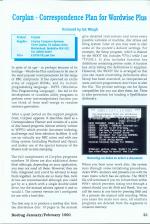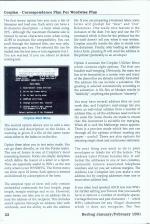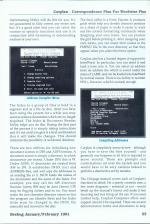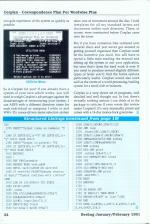Corplan (Corplan Computer Systems)
In spite of its age - or perhaps because of its heritage - Wordwise Plus continues to be one of the most popular word processors for the range of BBC computers. It has spawned an entire army of support ROMs, and its in-built programming language - WPPL (Wordwise Plus Programming Language) - has led to the development of countless utility programs to perform every text-manipulatory function you can think of from mail-merge to random sentence generation.
After a quiet period on the support program front, Corplan appears. It describes itself as a Correspondence Planner and consists of a suite of disc-based programs (almost entirely written in WPPL) which provide document indexing, mail-merge and form selection facilities. It will run on virtually any BBC micro and with any filing system (including Watford and Opus), and makes use of the special features of the Master such as date stamping.
The full complement of Corplan programs numbers 18 (there are also additional demo files) although, depending on your application, you may not need all these. However, they are fully integrated and you'd be advised to keep them together. As there are so many files, twin drives are recommended although you could get by at a pinch with a single double-sided drive, but the manual advises against it and so would I. The current version isn't configured for use with a hard disc.
The first step is to produce a working disc from the distribution disc. 10 pages in the manual give detailed instructions and cover every possible variation of machine, disc drives and filing system. Later on you may want to alter some of the system's default settings. For example, the Setup program, which is chained by the !BOOT file, includes *TV0,1 while I use *TV255,1. It also includes function key definitions containing printer codes. A function keystrip listing the definitions is supplied.
However, the !BOOT file is arranged so that you can insert overriding definitions after Setup has been executed, so inexperienced users and non-programmers don't have to alter the file. The printer settings are for Epson compatibles but you can alter these, too. There is also provision for loading a SpellMaster dictionary.
When you boot your work disc, the system runs through some initialising procedures, clears WW+ memory and presents you with the main menu which has six options. The !BOOT file will terminate if you try to boot from within WW+ which prevents losing text through a reboot should you hit Shift and Break. You can call the menu at any time by pressing Shift and f9, a process the manual calls recycling. When you enter the main text area, all ancillary programs are deleted from the segments to conserve memory.
The first menu option lets you scan a list of filenames and load one. Each entry can have a 30-character description - a boon when using DFS - although the maximum filename size is limited to seven characters even when using ADFS to maintain file compatibility. You can scroll through the indexed files, one way only, by pressing any key. The selected file can be loaded into the text area or into segments 0 or 1. You are warned if you are about to delete existing text.
The second option allows you to add a new filename and description to the Index. A warning is given if a file of the same name exists either in the Index or on the disc.
Option three takes you to text entry mode. You can go there directly, or via the Forms menu. The use of forms is one of Corplan's most interesting features. Forms are simply templates which define the layout of a letter or a report.
They are especially useful in WW+ as the text entry screen is not WYSIWYG. The Forms menu can show up to 22 forms. Each option is lettered and followed by a description of the form.
The simplest type of form will only contain embedded commands for line length, page length, margin settings and so on. However, some forms can take you to an address file to load the address of the recipient. This includes search options (through an address file) with wildcards, and the ability to edit the address file. If you are preparing a business letter, some forms will prompt for 'Your' and 'Our' References. One really nice feature is the inclusion of the date. I'm lazy and use the PD command which is fine for the printout but the file itself doesn't tell you when it was written.
Corplan actually inserts the date in words into the document. Finally, after loading an address into a form, pressing f9 will send the address to the printer (preferably to an envelope).
Option 4 accesses the Corplan Utilities Menu which contains eight options. The first one handles mail-merging. Obviously, the main text has to be formatted in a certain way and many of the demo files are already suitably formatted.
The address file can include a salutation. The greeting is selected automatically according to the salutation. A Sir, Sirs or Madam results in "faithfully", anything else produces "sincerely".
You may have several address files on your work disc, and Corplan's mail-merge lets you select an individual address from a number of address files, so all the addresses need not be in the same file. Some checks are made to ensure that the document is suitable for merging. When all is well the Mailmerge menu appears There is a preview mode which lets you run through all the options without wasting any paper - useful! There are also options for selecting single sheet and continuous stationery.
The next thing you need to do is print envelopes or labels for all the letters. The Address Label Printer handles this. It will format the addresses in one or two columns, optionally remove associated telephone numbers and let you set various margins. The Address List Compiler lets you make a new address list by copying addresses from one or more other address lists.
If you often load spooled ASCII text into WW+ for further editing you'll know that you usually have to remove a number of multiple spaces, Carriage Returns and pad characters - | - which WW+ substitutes for any 'illegal' characters which it does not recognise. The Text Deformatting Utility will do this for you. It's not guaranteed to fully correct any errant text but it's a good start and you can tailor the routine to specific functions and use it in conjunction with formatting or deformatting routines of your own.
The Index to a group of files is held in a segment and as a file on disc. After you have been using the system for a while you may want to remove documents which are no longer required. The Index & Document Weeder Utility helps you do this. During the first part of the process it is simply taking instructions and it's not until you give it a final confirmation that it will make the changes. This should minimise the possibility of accidental deletions.
There are two utilities for initialising new document sources in DFS and ADFS formats. A document source is simply a directory in which documents are stored. Under DFS this is W. Under ADFS, 10 directories are created from AW to JW. It establishes INDX (sic) and ADDRESS files, and will copy the addresses in an existing file to it. INDX holds the names of the documents and the name of the Index. For example, you may call the AW directory Business Letters, BW may be Aunt Harriet, CW may be Begging Letters and so on. You must retain the two-character directory names so that the program can identify them and the Index titles must be changed in the INDX file manually and resaved to the disc.
The final utility is a Form Planner. It produces grids which help you identify character positions on a sheet of paper to make it easier to work out the correct formatting commands when designing your own forms. You can preview the grid before printing it. After designing your own forms, you can insert their names in the FMENU file in the root directory so that they appear when you select the forms option.
Corplan also has a limited degree of support for InterWord. In particular, you can enter it and load a form into it. You can select an address from an address file which is saved under the name of LABEL and can be loaded into InterWord by normal means. There is no facility to re-enter WW+, however, which is natural enough.
Corplan is completely menu-driven - although you have to save the files yourself - and generally one keypress is all that is required to move around. There are prompts and confirmations all over the system and you would have to be very careless indeed to perform a destructive act by mistake.
The 120-page manual covers each of Corplan's functions in detail. On a purely cosmetic note, a few more diagrams - essential or not - would break up the manual's layout and make it less daunting and less tiring on the eye. If you need further help, Corplan Computer offers user support should it be required. There are several demonstration forms and documents to help you gain experience of the system as quickly as possible.
So is Corplan for you? If you already have a system of your own which works, you will need to weigh Corplan's advantages against the disadvantages of restructuring your system. I use ADFS with a different directory name for each individual or company I write to and WW+ II's cursor-driven menu selection system takes care of movement around the disc. I hold templates for all my standard letters and documents within each directory. These, of course, were constructed before Corplan came onto the scene.
But if you have numerous files scattered over several discs and just never got around to getting yourself organised then Corplan could be the incentive you need. You will have to spend a little time reading the manual and setting up the system to suit your application, but once that's done the hard work is over. If you need to produce several slightly different types of letter you'll find the forms options particularly useful. Corplan would also work well as the centre of a word processing/mailing system for a small club or business.
Corplan is a very clever set of programs, well detailed and well thought out. In fact, there's virtually nothing serious I can think of in the package to criticise (I even wrote this review under Corplan!). It's very reasonably priced and comes with a 14-day money-back guarantee.
This article was converted to a web page from the following pages of Beebug Volume 9 Number 8.


 1st January 1991
1st January 1991



